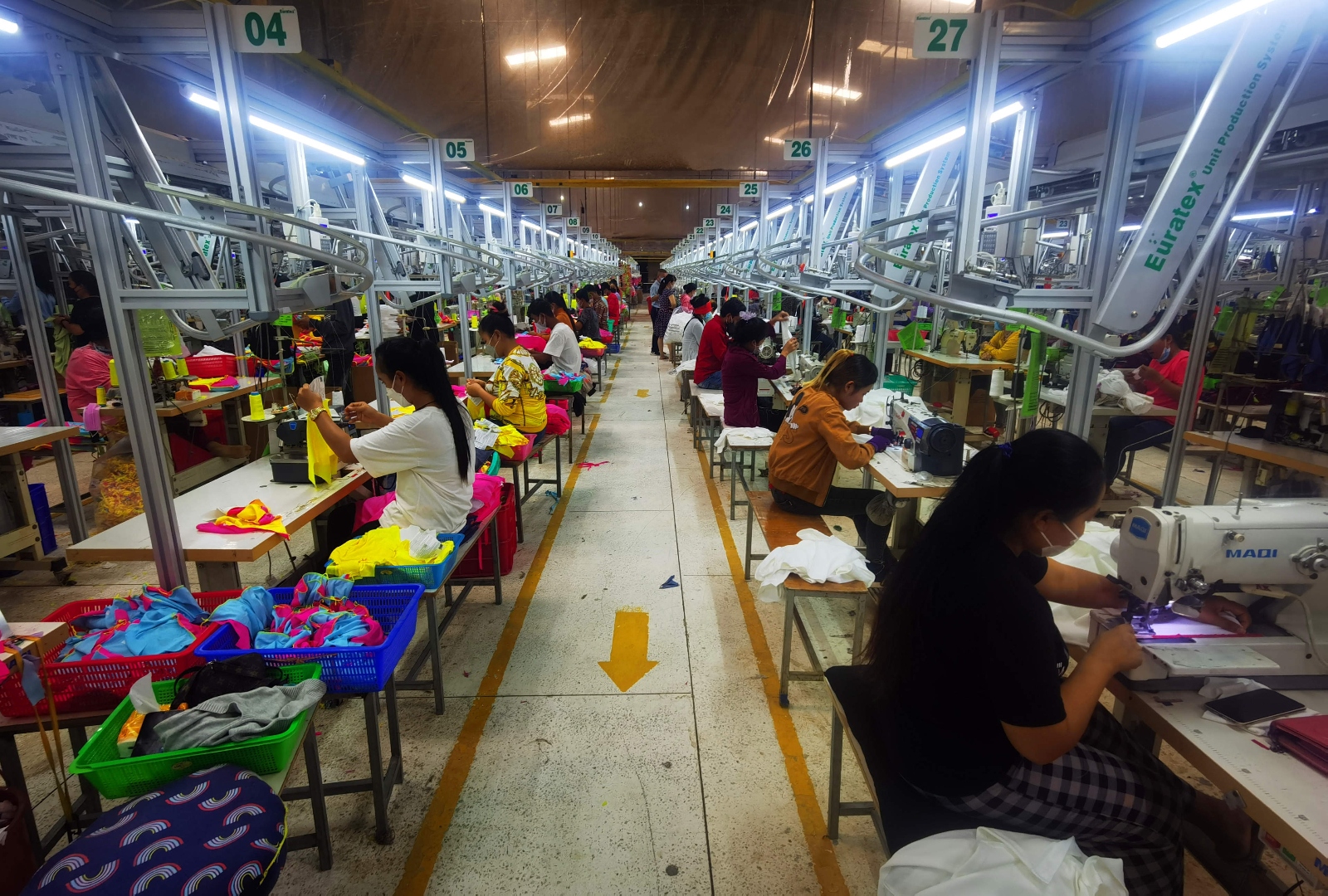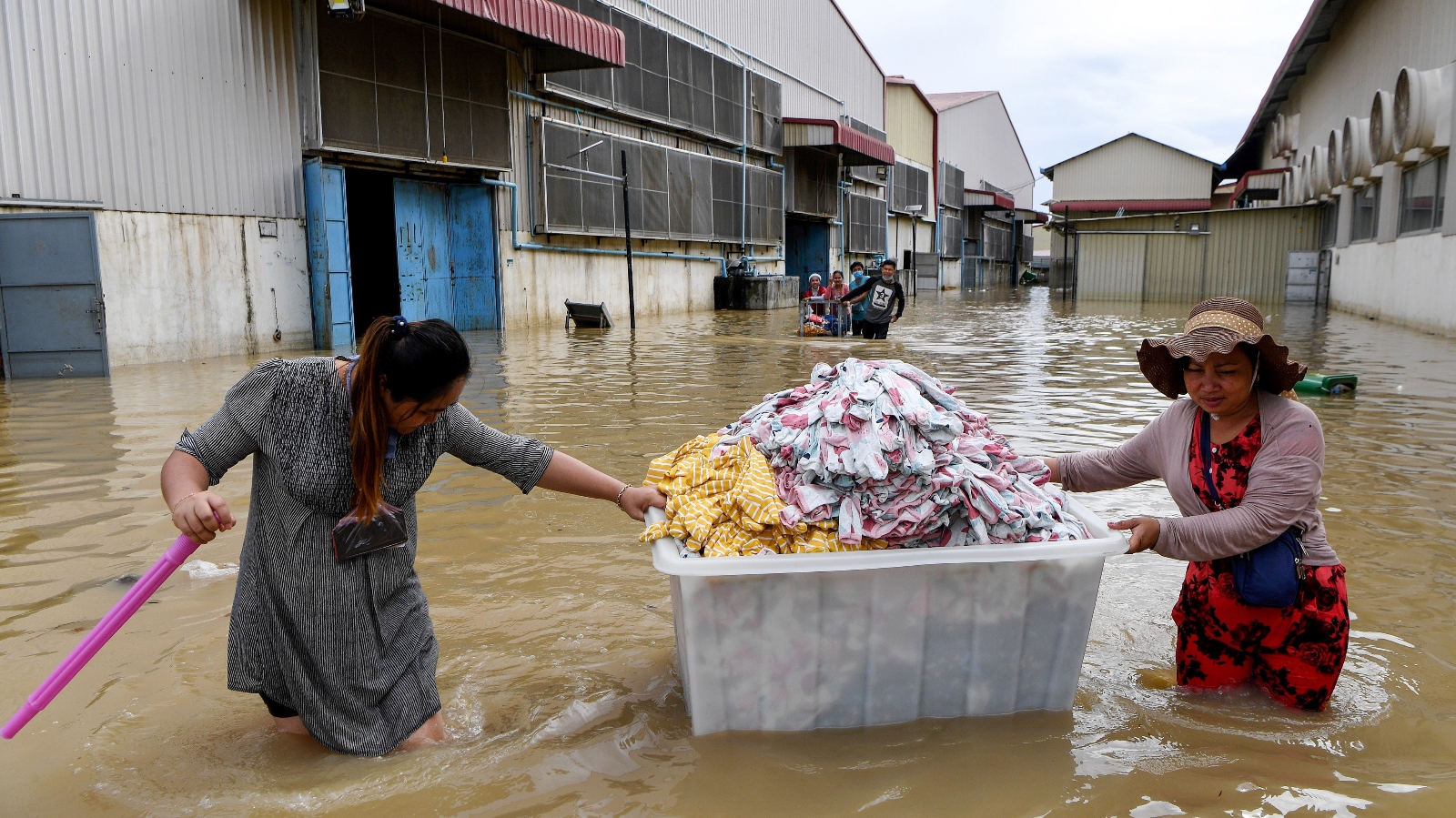This story is published in partnership with The Fuller Project.
As Nour feeds another half-finished pair of pants through her sewing machine, her arms begin to shake. Amid the whir of fans, her T-shirt sticks to her like skin. She fights to focus, knowing full well her target of up to 100 pieces an hour isn’t going to hit itself.
“I am completely soaked in sweat,” the 38-year-old says of her work shifts. “The heat makes me exhausted.”
Nour, who asked to use a pseudonym out of fear of reprisal from her employer, works at Yakjin, a South Korean-owned garment factory in Cambodia. More than 2,500 employees here stitch apparel for major U.S. giants like Walmart and Gap. Workers at Yakjin say the heat often leads to near-fainting episodes, fatigue, and dehydration. With no windows, the air feels stifling but their requests for fans are at times ignored.
Workers at three other factories in Phnom Penh, the country’s capital, producing clothes for brands like Primark, H&M, and Old Navy (owned by Gap Inc.), told similar stories of worsening heat.
Around the world, fashion’s mostly female labor force is grappling with working conditions made increasingly unbearable and unhealthy by climate change. Women picking cotton in India’s sun-baked fields are toiling in temperatures of roughly 113 degrees Fahrenheit, while workers in Ghana’s Kantamanto — one of the world’s largest secondhand markets where clothing discarded by Western consumers is resold — are losing vital wages when flooding prevents trade. Nour is just one of nearly 1 million garment workers in Cambodia, a country that has experienced roughly 1.4 degrees F of warming per decade since the 1960s.

Fashion has had a devastating impact on the planet, producing more greenhouse gas emissions than aviation and shipping combined. So far, labor experts say, the more than $2.5 trillion industry has mostly focused its climate change efforts on mitigation, such as using more recycled fabrics, while largely ignoring how it impacts workers.
“[Labor] violations in factories are so gross, as in so widespread, and so awful … that that’s where the attention has been,” said Liz Parker, an associate member of Clean Clothes Campaign, an Amsterdam-based alliance of labor unions and nongovernmental organizations. “But workers are suffering from heat stress, from flooding, from water pollution … and we need to protect [them] from that as well.”
To expose how climate change is impacting workers throughout fashion’s supply chain, The Fuller Project tracked products from several brands — including Walmart, Primark, H&M, Gap, and Old Navy — across several countries. At each stage, women play a vital role in the global business of fashion, yet their livelihoods — and lives — are being increasingly threatened by extreme weather.
Cotton fields appear outside the car window an hour into the drive from Ahmedabad, capital of Gujarat state on India’s western coast. In every field, a woman in a sari is scooping cotton blossoms into a bag, spots of bright color that punctuate green fields topped with white fluff.
Roshan Osmanbhai arrives at 7 a.m. daily and ties a strip of cloth around her head to protect it from the sun. By midday, the temperature will hit more than 80 degrees F. The last week of January is supposed to be the height of winter in Gujarat, with average temperatures hovering around 68 degrees F. She hasn’t felt that traditional winter for years.
India is the world’s biggest grower of cotton after China. Six million farmers make a living from the sector, most of them women, according to Better Cotton, a nonprofit that promotes sustainable production. Cotton’s global supply chain is complex and lacks transparency, but Primark and H&M both confirmed they source from India. Walmart, Gap, and Old Navy didn’t respond to The Fuller Project’s requests for comment, but nonprofits monitoring supply chains said they likely do as well.
“If you’re in the apparel business … you have to come here,” said Ashis Mondal, former director of Action for Social Advancement, an Indian nonprofit supporting small farmers. “You have no other option.”
Across the region, the farms might be run by women, but few of them own the land they cultivate. The precarious nature of their work is exacerbated further by the changing climate, with summers arriving earlier and monsoon rains delayed or declining, damaging crops. India recorded extreme weather events on nearly 90 percent of the days in the first nine months of 2023, according to The Centre of Science and Environment, a research organization based in New Delhi, killing nearly 3,000 people and ruining almost 5 million acres of crop area.

In Gujarat last year, summer rolled in before March, the women said. The temperature shot up to roughly 113 degrees F before anybody knew what to do. Women farmers complained the heat was making it hard to carry on. “The heat makes our skin itch,” said Jessuben Jhapra, a 49-year-old farmer. “Heat rash can erupt all over the body. Our eyes are under enormous strain.”
The weather patterns have invited new and unfamiliar pests, requiring pesticides that have created further health problems for the women. Most own protective gear — gloves, boots, goggles — but don’t always use them when it’s hot. Two years ago, Alayben Zilriya, a 55-year-old farmer with sharp cheekbones and thin-rimmed spectacles, sprayed pesticides on the plants using her bare hands. She got such a severe reaction that she had to visit the doctor for treatment. Today, the skin on her hands is still shriveled, her nails grayish.
Excessive temperatures can do serious harm to humans. Heat exhaustion sets in when too much water and salt is lost, usually due to excessive sweating. Symptoms include nausea, dizziness, thirst, and palpitations. It can be hard to think clearly — hot weather is linked to reduced cognitive function, judgement errors, and higher risk of occupational injury.
For Nour, this sounds familiar. Even though drinking water is available at her factory, she feels dehydrated and has little energy to work. When it’s hot she takes more toilet breaks but misses her hourly targets and says her supervisors at Yakjin become verbally abusive.
“They curse or insult us,” she explained. “They blame us.”
Workers at Yakjin interviewed by The Fuller Project said they often feel ill or faint. Ry, 38, who has been employed at the factory for over a decade, thinks the heat is getting worse. Climate change is part of the problem, he says, but also fans aren’t maintained or replaced. While the building has fans that blow mist to keep workers cool, they do not reach all employees. For over two years, Ry has asked the factory for more, but says his requests have fallen on deaf ears.
Only a small handful of Cambodia’s roughly 1,300 garment factories have air conditioning, according to Seang Yot from The Coalition of Cambodian Apparel Workers’ Democratic Union, or C-CAWDU.
At lunchtime, Yakjin employees hang cloth above their heads in the outdoor canteen for extra shade. In heavy rains during the wet season, the area floods, as does the factory, workers told The Fuller Project. Cambodia is already highly vulnerable to flooding, including flash flooding, but projected climate change trends indicate this is only set to get worse — affecting tens of thousands more people each year by 2030. Workers are concerned about electric shocks as flood water comes in contact with the factory’s electrical systems, said Nour, though no one has been hurt yet.
“Anything involving money is always a problem,” explained Ry, who also asked to use a pseudonym. “The factory managers don’t care about how heat impacts us, only that we speed up and work faster.”
In an email, Yakjin Cambodia’s management said the factory maintains “a comfortable indoor temperature with cooling and ventilation systems,” including fans and air conditioners, but said there was no AC in the sewing line.
They said there have been no reported cases of fainting in the past two years, and that exhaustion could have many causes including inadequate healthcare, exercise, and lack of sleep, as well as heat.
There are grievance mechanisms in place for workers and no one had reported supervisors becoming verbally abusive when production targets were missed. Yakjin said the factory does not flood during the rainy season and there was no risk of electric shock.
Walmart, which sources from Yakjin, said it “does not tolerate unsafe working conditions” and is looking into the matter.
While Cambodia has always been hot, extreme heat now presents a major threat to human health. The country’s garment sector is particularly vulnerable to climate change because it emerged largely ad hoc with little oversight, according to a 2022 report led by Laurie Parsons, senior lecturer in geography at Royal Holloway, University of London.

Many of the factories, for example, are technically warehouses. “They’re not built for humans,” said Parsons. Most are also privately rented, which means factory owners have little power — or incentive — to implement changes, added Yot.
Cambodia’s labor law sets no limit on workplace temperatures, saying only that they must be “reasonable for employees.” In neighboring Thailand, with a similar-sized garment industry, the maximum is 93 degrees F wet-bulb temperature (a way of measuring heat stress that takes into account factors like temperature and humidity, among others).
Over two days, The Fuller Project asked a garment worker to measure temperatures using a digital thermometer in the sewing section of Jade Sun Garment, a factory producing for brands like Primark, Old Navy, and George, a British clothing line sold widely in Walmart. Recordings taken by a garment worker in February, one of the cooler months, hit 97.7 degrees F.
During the hottest months, from April to May, the country’s daytime outdoor temperatures can soar above 104 degrees F. Leakhena, a soft-spoken sewer who’s worked at Jade Sun for several years, often feels “nearly unconscious” during this period. “We need more oxygen,” she explained. “I cannot breathe properly.”
The water provided by the factory isn’t clean either, she said. “It smells a lot. When we drink water from that tap it gives us a sore throat.”
In response to inquiries from The Fuller Project about workers’ claims, Gap Inc. said it is opening investigations into Yakjin and Jade Sun Garment and will take appropriate action to remediate any breach of its policies. Primark is aware of the issues raised in connection with Jade Sun Garment and is in the process of “supporting remediation” with its management, adding that the safety of workers in its supply chain is “extremely important” to the company. Jade Sun Garment and George did not reply to multiple requests for comment.
In an email, Heng Sour, Cambodia’s Minister of Labour and Vocational Training, said the government is “deeply concerned” about worker welfare. He said The Fuller Project’s temperature recording at Jade Sun Garment offered a “limited view” because it used a single thermometer but pointed to the need for a “more detailed analysis to accurately assess and respond to temperature conditions.” The government is also in the process of “potentially” establishing maximum workplace temperatures and since being contacted has accelerated the deployment of additional cooling systems to factories.
Once their shift is over, women return home — yet there is no reprieve from the soaring temperatures. Many live in privately rented dormitories, often single-bedroom dwellings with low, metal roofs and little protection against extreme weather. Several workers described them as virtually unlivable in the heat.
“I want to see change,” said Leakhena, who also asked to use a pseudonym for fear of reprisals. “The heat is making us more exhausted every day. We don’t know what impact it will have on our health after five or 10 years. And by that point, it’s already too late.”
Inside Accra’s bustling central business district lies Kantamanto. A sprawling complex packed with vendors who sell what’s known locally as obroni wawu or “dead white man’s clothes.”
Ghana was the largest importer of used clothing in 2021, with $214 million worth of garments passing across its borders. When consumers in the United States or United Kingdom donate their old T-shirts, only 10 to 30 percent are resold in stores. The rest disappears into a vast network, often ending up here, West Africa’s hub for used garments from the West. In Kantamanto, stalls sell clothing from Primark, H&M, Walmart, Gap, and Old Navy.
Young women and teenage girls move through the market balancing 120-pound bales of clothing on their heads. Known as kayayei, they transport bales from importers to stalls, storage, and disposal sites, earning 30 cents to $1 per trip. The market’s narrow aisles don’t allow for motorized modes of transport, so the women play a crucial link in the secondhand supply chain. Their work frequently causes neck and spine injuries, said Liz Ricketts, co-founder of The Or Foundation, a Ghana and U.S.-based nonprofit. They also face sexual violence, including rape, and are at high risk of unplanned pregnancies, according to the United Nations.
Many are here because climate change has made farming in their villages unviable, but the cities have proven to be no refuge either. Ghana is experiencing more intense and frequent flooding and storms as global temperatures tick up. In Kantamanto, clothing waste clogs the gutters, which exacerbates the flooding, says Ricketts, and leads to an increased risk of cholera and malaria.

The market is open every day but Sunday. When clouds gather, 18-year-old Mariam Karim starts to worry. She earns roughly $14 a week carting bales of secondhand clothes from trucks, which covers her basic needs such as rent and food. During the rainy season, fewer customers show up and the market shuts roughly twice a month from flooding, according to Ricketts, often leaving women without pay.
A downpour can also mean no sleep. “Flooding at my home is common,” said Karim, who lives near the market in a wooden, makeshift dwelling. “I will usually scoop the water out of my room until it subsides. It is scary because colleagues have even lost their lives and properties.”
West Africa is a climate change hotspot and Accra’s low elevation makes it particularly vulnerable. After more than three decades working at Kantamanto, it’s something Daniel Ampadu, vice chairman of the Kantamanto Used Clothing Association, has seen with his own eyes.
“I am old enough so I can tell you that these days, so much rain comes … and many places, especially our market, gets flooded,” he said. “This wasn’t the case 30 years ago.”
Of the five brands examined across India, Cambodia, and Ghana, only Primark and H&M provided details in response to queries about what they are doing to protect workers in their global supply chain from climate change. Primark said it knows it must “act to mitigate” the causes and effects of climate change and support its supply chain partners in similar efforts, such as educating farmers in its Sustainable Cotton Programme, a training scheme. H&M said it is aware of the impact that climate change has on the people in its supply chains and will “constantly review and adapt” the scope of its climate-related risks.
For decades, the fashion industry’s exploitation of workers in low-income countries has been well documented. But a new challenge now presents itself: Who will protect them from a climate crisis that the very same industry helped bring about?
Better Factories Cambodia, a partnership between the International Labour Organisation, the U.N.’s labor agency, and the International Finance Corporation, has repeatedly recorded what it says are unacceptable workplace temperatures during inspections. Although some factories have invested in improved lighting and better ventilation, most need to do more, it says. More recently, fashion brands involved in Action, Collaboration, Transformation, or ACT, a global agreement aimed at transforming the garment industry, have begun to discuss ways to solve the heat problem for workers, said Yot. Unless extreme heat and flooding are addressed, countries vital for fashion production, including Cambodia, risk losing $65 billion in export earnings and 1 million potential jobs by 2030, according to research by Cornell University’s Global Labor Institute.
“The buck stops always with the brands,” said Parsons. “[But] it’s kind of like pushing an open door … They’re like, yes, we should think about this, but they haven’t yet.”
For Nour, she’d simply like to feel cool air on her face. Or the freedom to catch her breath. After work, she showers, washing away the sweat. For a brief moment, she feels alive, before being engulfed by the factory’s heat once more.
Additional reporting by Sineat Yon
The Fuller Project is a nonprofit newsroom dedicated to the coverage of women’s issues around the world. Sign up for the Fuller Project’s newsletter, and follow the organization on X or LinkedIn.


